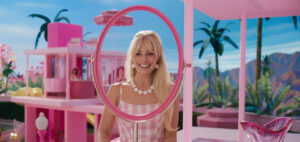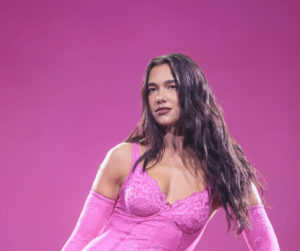There’s a moment in Taylor Swift’s music video for “Look What You Made Me Do” in which all the ghosts of her past stand in a line as though they’re about to be executed by firing squad — only instead, they begin sniping at each other. The geeky, T-shirt-wearing Taylor of the early-career “You Belong With Me” is dissed by the prima ballerina from “Shake It Off”; the ringmaster Taylor from the 2012 Grammys calls the weeping young “Fearless” Taylor a fake and a victim. It’s played for laughs, but there’s a darker subtext, one of deep shame and self-loathing. “Oh, you hate me?” it seems to say. “Not anywhere near as much as I hate myself.”
There are other ways to read this scene, of course, including as a metaphor for the adolescent search for one’s most authentic self: these Taylors must be destroyed so that the one true Taylor can rise in their place. It’s also a clear aesthetic precursor to her current, worldwide “Eras” tour, in which Swift cosplays her way through her twenties, performing hits from throughout her career.
But the squabbling Swifts are also an apt representation of the life cycle of any American pop star, whose survival in an ever-shifting culture relies on continuous self-reinvention. It’s not enough to keep writing, singing, performing; she also has to metamorphose, emerging every few years as something enticingly but not entirely different. Remaining nimble, fresh and hungry is paramount. There are, after all, a thousand slavering ingenues ready to take her place.
This cycle is inescapable, whether the pop star is a young woman at the height of her power, like Swift, or a grande dame looking back at a career that has spanned five decades, eight presidential administrations, and the dawn of a new millennium. Madonna, who stepped back onstage last weekend for a six-month “Celebration” tour across Europe and the US, is joined during the performance by lookalikes sporting her most iconic outfits from albums and tours past: the Jean Paul Gaultier cone bra from “Blonde Ambition”, the diamond drip of “Material Girl”, the Marie Antoinette getup from “Vogue”. Unlike Swift, Madonna doesn’t fight with the ghosts of her former selves. She flirts with them, fondles them, welcomes them like old friends.
This is an extraordinary moment in musical history: two of the most powerful and successful female musicians ever to exist, each back onstage in a blockbuster, career-spanning spectacle centred on her own timeless status. The obvious difference is that only one of these women has been around long enough to merit such a sweeping retrospective; the unspoken absurdity of Swift’s tour is that she’s not just revisiting her past artistic personas, but also acting like a far older, more seasoned performer than she is.
At 33, Swift doesn’t have eras to look back on; she has phases. And while her adolescence may not have been typical — professionally, at least, she’s accomplished more in the last 10 years than many people will in a lifetime — precociousness is not a substitute for the perspective that comes with age and experience. It certainly doesn’t put her in the same league as the 65-year-old Madonna, a mother of adult children who performs with a face shot full of dermal fillers and a brace on her arthritic knee.
As a product of the Xennial microgeneration born between 1978 and 1984, I’m almost exactly the same age as Madonna’s career, which also makes me young enough to remember when Taylor Swift was a teenage country singer whose song-writing skills were superior to her singing voice by an order of magnitude. What strikes me most now, comparing them, is that neither would have thrived in the other’s time. Madonna, with the physicality of a modern dancer and the sensuality of a teenager in the throes of sexual awakening, was made in and for the Eighties. Swift, a famously bad dancer but extraordinary lyricist, understood intuitively how to exploit the power of both online fandoms and the new tabloid press, titillating both with songs that may or may not have been cryptic diss tracks aimed at the famous men she’d dated.
With their sexual politics, both women know how to manipulate their particular cultural moment: in her mid-20s, Madonna was triggering the prudes with “Like a Virgin”, not to mention the Pope with “Like a Prayer”; at the same age, Swift shrouded her sexuality in a high school-style coyness that coincided perfectly with the neo-chaste mores of the #MeToo movement. Even now, in the midst of a high-profile romance with NFL player Travis Kelce that saw reporters staking out Kelce’s home in order to breathlessly report that Swift had spent the night, her public persona is still, to borrow a phrase, like a virgin.
This dichotomy also extends to their wardrobes for their respective tours: Madonna has fully leaned into the dominatrix aesthetic with which she’s been flirting since her 1992 Erotica album. She showed up at the Grammys this year carrying an actual riding crop. Swift, meanwhile, takes the stage wearing spangled leotards that look like adult-sized reproductions of the outfits the contestants wear on Toddlers and Tiaras.
And then, there’s their actual politics — or conspicuous lack thereof. Madonna was an icon for gay men at a time when doing so was politically unpopular if not artistically risky: her new show features a video memorial to all the friends she lost to the Aids epidemic. For Swift, meanwhile, it was remaining apolitical that attracted criticism; her refusal even to signal her leanings eventually became something of a media obsession. The Christian conservative Moral Majority that commanded Madonna to shut up in the Eighties was replaced in the 2010s by an equally powerful cabal of influencers on the now-culturally-dominant Left for whom Taylor Swift’s political silence was taken as an affront. Madonna was banned by MTV and excommunicated by the Catholic Church; Swift, who had the bad luck to be wildly successful at the precise moment that the culture declared war on basic white women, was accused of courting white supremacists and neo-Nazis as fans — and perhaps being a closet fascist herself. Finally, she “came out” as a Democrat.
But you could tell she didn’t want to — nor has her heart really been in her subsequent, tepid engagements with the culture wars. Even the rainbow-spangled video for “You Need to Calm Down”, which stars various Queer Eye cast members and is the closest Swift has ever come to an anthem for the LGBT community, feels more like a Walmart Pride Month commercial than a bold political statement.
After all, Swift is far more interested in her own career than its cultural backdrop. And in that respect, she has a lot to brag about: 12 Grammy awards, nine number one hit singles, a $740 million fortune. But the one thing she doesn’t have, at least not yet, is a cultural legacy that merits a three-hour celebration of her eras. Even the music she performs on this tour has no broader relevance, no anchor point outside the artist’s own life. The only way to identify a given Taylor Swift era is to look at Swift herself: who she was dating, what she was wearing, which ex or fellow artist was she beefing with.
Madonna’s music, meanwhile, is inextricable from its historical context; her concert is a journey through time from the excesses of the Eighties, through Y2K, and into the glittering now that is also the twilight of her career. Although she doesn’t say so outright, and although she’s certainly in great shape for a nearly-septuagenarian, it seems likely that this is Madonna’s last tour. Even her eerie waxwork appearance, the object of almost as much scrutiny as the music itself, ironically highlights just how long she’s been with us; in 2023, a preternaturally smooth face is as much a marker of age as a wrinkled one. Looking at her, we understand: this is the face of a woman who has seen some shit.
What has Taylor Swift seen? Not much, but maybe enough to know that she doesn’t want to be a Madonna, that surviving for decades in this industry isn’t always a blessing. Consider the personas of her “Eras” tour, and what they truly represent — not the musical evolution of a veteran artist, but a young woman’s multi-year battle for control over her public image. All these different Taylors — the princess, the rebel, the baby feminist, the hipster — are less a creative product than a reactionary one, an attempt to wrestle her identity back from a hostile media apparatus that wants to conscript her unwillingly into the culture wars and define her in the most unflattering possible terms. “No, this is who I am.” And yet, Swift must also be aware that if she sticks around long enough, that battle will eventually end.
The new challenge, as the years go by and the culture evolves, will be convincing people to care about her at all. You could forgive Swift for deciding she would prefer not to do this — that she would rather take her eras in the form of a 15-year retrospective than one three times that long — especially when Madonna is onstage as the living, breathing, knee-braced embodiment of what it takes to stay in the game. Swift has been around long enough to reinvent herself a few times, but she hasn’t experienced the brutal highs and lows that come from a lifetime in the spotlight, the devastation when, say, the album you poured your soul into becomes a critical disappointment. Or when Patti Lupone tells the world you can’t act. Or when your ageing body becomes an object of mockery — but then so does whatever you do to address it. When nothing will ever be good enough for the people who want to see you fail, and the only person who believes in you is you. Madonna is an icon, a queen, a goddess — but she’s also a 65-year-old woman in a leather bustier, saying, I deserve this. Saying: Look at me.
And if you’re a young star, perhaps you do look. You look at her life. Look at her face. Look at the risks she’s had to take, the hardships she’s had to endure; look at what it looks like, what it really looks like, to try, and fail, and flop, and finally claw your way back to relevance. It’s audacious. It’s awesome. It can even be sexy. But it’s not pretty.
Disclaimer
Some of the posts we share are controversial and we do not necessarily agree with them in the whole extend. Sometimes we agree with the content or part of it but we do not agree with the narration or language. Nevertheless we find them somehow interesting, valuable and/or informative or we share them, because we strongly believe in freedom of speech, free press and journalism. We strongly encourage you to have a critical approach to all the content, do your own research and analysis to build your own opinion.
We would be glad to have your feedback.
Source: UnHerd Read the original article here: https://unherd.com/



